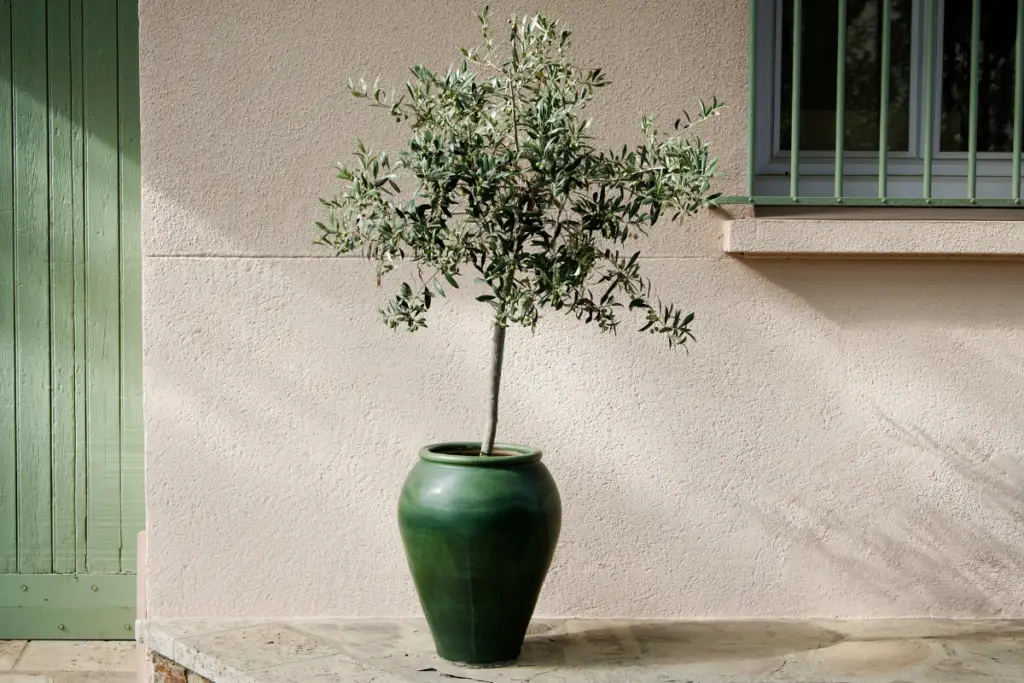Olive trees are a popular choice for gardeners and landscapers alike, thanks to their hardiness and ability to adapt to various growing conditions.
While these trees are typically grown in the ground, they can also thrive in containers, making them an ideal choice for those with limited space or who want to grow olives indoors.
The question many gardeners have is how fast do olive trees grow in pots?
The growth rate of olive trees in pots depends on several factors, including the variety of tree, the size of the container, and the growing conditions.
Dwarf varieties of olive trees are often used for container gardening, as they are smaller and more compact than their full-sized counterparts.
In general, olive trees grown in pots will not grow as large as those grown in the ground, and their growth rate may be slower due to the limited space and nutrients available in the container.
Despite their slower growth rate, olive trees can still thrive in containers if they are given the right conditions.
Gardeners should ensure that their olive trees are planted in well-draining soil, as these trees do not like to have their roots sitting in water.
They should also be watered regularly and given a balanced fertilizer to promote healthy growth.
With the right care and attention, olive trees can be a beautiful and productive addition to any container garden.

Table of Contents
Understanding Olive Trees
Olive trees are an evergreen tree species that can grow up to 50 feet tall in the wild, but typically grow to about 20-30 feet tall in cultivation.
They are known for their silver-green leaves and small, white flowers that bloom in the spring.
Olive trees are native to the Mediterranean region, but they can be grown in many parts of the world, including in pots.
Species of Olive Trees
There are many different species of olive trees, but the most commonly grown species is the Olea europaea.
This species is known for its hardiness and adaptability, making it a popular choice for cultivation.
However, there are also many different cultivars of the Olea europaea, each with its own unique characteristics.
Ideal Conditions for Growth
Olive trees require a warm, sunny climate to grow well. They are hardy to USDA zones 8-11, which means they can tolerate temperatures down to about 10°F.
Olive trees also require well-draining soil, as they are susceptible to root rot in wet conditions. When grown in pots, it is important to use a well-draining soil mix that is specifically formulated for container plants.
In addition to the right soil mix, olive trees also require regular fertilization. A balanced fertilizer with a ratio of 10-10-10 is ideal for olive trees.
They should be fertilized every 4-6 weeks during the growing season, which typically runs from late spring to early fall.
Finally, olive trees require regular pruning to maintain their shape and promote healthy growth.
Pruning should be done in the late winter or early spring, before new growth begins.
It is important to remove any dead or diseased branches, as well as any branches that are crossing or rubbing against each other.
Pot Growing vs Ground Planting
When it comes to growing olive trees, there are two main methods: pot growing and ground planting. Each method has its own benefits and challenges.
Benefits of Pot Growing
Pot-growing olive trees is a popular option for those with limited space or who want to grow olive trees indoors.
One of the main benefits of pot growing is that it allows for greater control over the growing conditions.
This means that the soil, water, and nutrients can be tailored to the specific needs of the olive tree.
Another benefit of pot growing is that it allows for easier maintenance and harvesting.
Olive trees grown in pots can be easily moved, pruned, and harvested without disturbing the surrounding soil or plants.
Challenges of Pot Growing
While pot-growing olive trees has its benefits, there are also some challenges to consider.
One of the main challenges is that olive trees grown in pots may not grow as large or produce as much fruit as those grown in the ground.
This is because the roots of olive trees grown in pots are confined to a smaller space, which can limit their growth and nutrient uptake.
Another challenge of pot growing is that it requires more frequent watering and fertilizing.
Olive trees grown in pots can dry out quickly, especially in hot weather, and may require daily watering to prevent stress and damage.
When deciding whether to grow olive trees in pots or in the ground, it’s important to consider the specific needs and limitations of the growing space.
Pot growing can be a great option for those with limited space or who want greater control over the growing conditions, but it may not be the best option for those looking to grow large, fruit-producing olive trees.
Growth Rate of Olive Trees in Pots
Growing olive trees in pots is a great way to enjoy this beautiful and useful tree even if you have limited space.
Olive trees can be grown in pots both indoors and outdoors, and they can thrive as long as they receive proper care.
However, the growth rate of olive trees in pots is different from those planted in the ground.
This section will explore the growth rate of olive trees in pots and the factors that influence it.
Factors Influencing Growth Rate
Several factors can influence the growth rate of olive trees in pots. The most important ones are:
- Pot Size: The size of the pot can affect the growth rate of olive trees. A small pot can restrict the root system and limit the growth of the tree. On the other hand, a large pot can provide more room for the roots to grow, resulting in a faster growth rate. A pot that is at least 20-22 inches in diameter is recommended for growing olive trees.
- Soil Quality: The quality of the soil can also affect the growth rate of olive trees. Olive trees prefer well-draining soil that is rich in nutrients. A soil mix that includes potting soil, perlite, and small rocks can provide the ideal growing conditions for olive trees in pots.
- Watering and Fertilizing: Proper watering and fertilizing can help olive trees grow faster. Olive trees in pots need to be watered regularly but not overwatered. Fertilizing with a balanced fertilizer can also help promote growth.
Average Growth Per Year
The growth rate of olive trees in pots varies depending on several factors, including the variety of the tree, the size of the pot, and the growing conditions.
On average, olive trees in pots can grow up to 10 feet tall, but this may take several years.
During the first year, olive trees may not show much growth as they adjust to their new environment.
However, in the second to third year, olive trees in pots can grow up to 12 inches per year.
After the third year, the growth rate may slow down, but the tree will continue to grow and produce olives as long as it is properly cared for.
Prices pulled from the Amazon Product Advertising API on:
Product prices and availability are accurate as of the date/time indicated and are subject to change. Any price and availability information displayed on [relevant Amazon Site(s), as applicable] at the time of purchase will apply to the purchase of this product.
Maximizing Growth Potential
Choosing the Right Pot
When growing olive trees in pots, it is important to choose the right size and type of container.
A pot that is too small can restrict root growth and limit the tree’s potential, while a pot that is too large can lead to overwatering and root rot.
The recommended pot size for growing olive trees is at least 20-22 inches in diameter.
It is also important to choose a pot made from breathable materials, such as clay or wood, to allow for proper aeration of the roots.
Proper Care and Maintenance
Olive trees in pots require proper care and maintenance to ensure maximum growth potential.
Here are some tips for caring for your potted olive tree:
- Water regularly, but make sure not to overwater. Only water when the top several inches of soil has dried out completely.
- Apply a fertilizer made specifically for olive trees every few months to provide necessary nutrients.
- Prune the tree regularly to encourage new growth and maintain its shape.
- Place the pot in a spot that receives at least six hours of full sunlight each day.
It is also important to keep an eye out for pests and diseases that can affect the growth and health of your olive tree.
Common pests include aphids, scale insects, and spider mites, while common diseases include verticillium wilt and anthracnose.
By choosing the right pot and providing proper care and maintenance, you can maximize the growth potential of your potted olive tree.
Common Issues and Solutions
Growing olive trees in pots can be a great way to enjoy fresh olives at home, but there are some common issues that can arise.
Here are some solutions to help keep your olive tree healthy.
Pests and Diseases
Olive trees can be susceptible to a variety of pests and diseases, including scale insects, spider mites, and fungal infections.
To prevent these issues, it’s important to keep your olive tree healthy by providing it with the right soil, water, and nutrients.
If you notice any signs of pests or diseases, such as yellowing leaves, discolored spots, or webbing on the leaves, take action immediately.
You can try spraying your tree with a natural insecticide, such as neem oil or insecticidal soap, or consult with a professional if the problem persists.
Overwatering and Underwatering
One of the most common issues with olive trees in pots is overwatering or underwatering.
Overwatering can lead to root rot and other problems, while underwatering can cause the leaves to wilt and turn brown.
To avoid overwatering, make sure your pot has good drainage and only water your tree when the top inch of soil is dry to the touch.
To avoid underwatering, make sure your tree is getting enough water by checking the soil moisture regularly.
If you suspect your olive tree is suffering from overwatering or underwatering, adjust your watering schedule accordingly.
You can also try adding a layer of mulch to help retain moisture in the soil or repotting your tree in a larger container with fresh soil.
By addressing these common issues, you can keep your olive tree healthy and thriving in a pot.
Conclusion
In conclusion, olive trees can grow well in pots as long as they are given proper care and attention.
The growth rate of olive trees in pots may vary depending on several factors such as the size of the pot, soil quality, sunlight exposure, and watering frequency.
However, with the right conditions, olive trees can grow up to 2-3 feet per year.
It’s important to note that olive trees are slow-growing trees, so patience is key when growing them in pots.
With consistent care and attention, you can enjoy the beauty and benefits of an olive tree in your home or garden.
- How to Dry Basil Leaves: A Professional Guide
- Is an Avocado a Fruit or Vegetable? Simple Answer and Explanation
- Does Pineapple Have Seeds? Exploring the Anatomy of Pineapples
- Blooming Through Winter: Can I Grow Vegetables Indoors in the Winter?
- What Can You Grow in a Greenhouse All Year Round: A Guide to Year-Round Greenhouse Gardening
- Are Blueberries Blue? Debunking the Myth of Their Color























